FIAT DOBLO PANORAMA 2015 2.G Owners Manual
Manufacturer: FIAT, Model Year: 2015, Model line: DOBLO PANORAMA, Model: FIAT DOBLO PANORAMA 2015 2.GPages: 323, PDF Size: 47.13 MB
Page 201 of 323
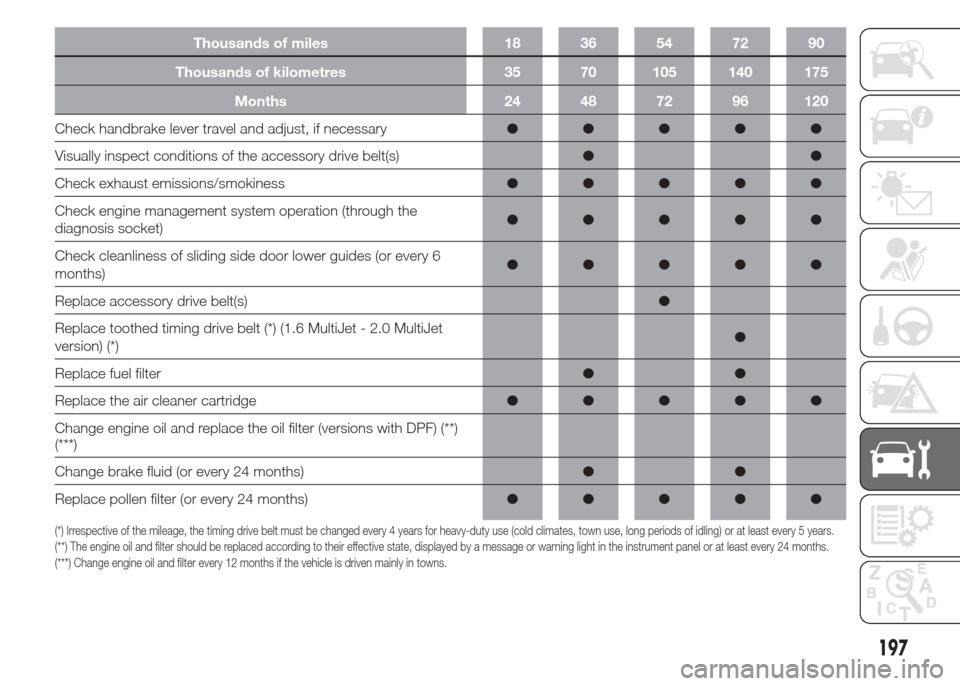
Thousands of miles 18 36 54 72 90
Thousands of kilometres 35 70 105 140 175
Months 24 48 72 96 120
Check handbrake lever travel and adjust, if necessaryâ—Źâ—Źâ—Źâ—Źâ—Ź
Visually inspect conditions of the accessory drive belt(s)â—Źâ—Ź
Check exhaust emissions/smokinessâ—Źâ—Źâ—Źâ—Źâ—Ź
Check engine management system operation (through the
diagnosis socket)â—Źâ—Źâ—Źâ—Źâ—Ź
Check cleanliness of sliding side door lower guides (or every 6
months)â—Źâ—Źâ—Źâ—Źâ—Ź
Replace accessory drive belt(s)â—Ź
Replace toothed timing drive belt (*) (1.6 MultiJet - 2.0 MultiJet
version) (*)â—Ź
Replace fuel filterâ—Źâ—Ź
Replace the air cleaner cartridgeâ—Źâ—Źâ—Źâ—Źâ—Ź
Change engine oil and replace the oil filter (versions with DPF) (**)
(***)
Change brake fluid (or every 24 months)â—Źâ—Ź
Replace pollen filter (or every 24 months)â—Źâ—Źâ—Źâ—Źâ—Ź
(*) Irrespective of the mileage, the timing drive belt must be changed every 4 years for heavy-duty use (cold climates, town use, long periods of idling) or at least every 5 years.
(**) The engine oil and filter should be replaced according to their effective state, displayed by a message or warning light in the instrument panel orat least every 24 months.
(***) Change engine oil and filter every 12 months if the vehicle is driven mainly in towns.
197
Page 202 of 323
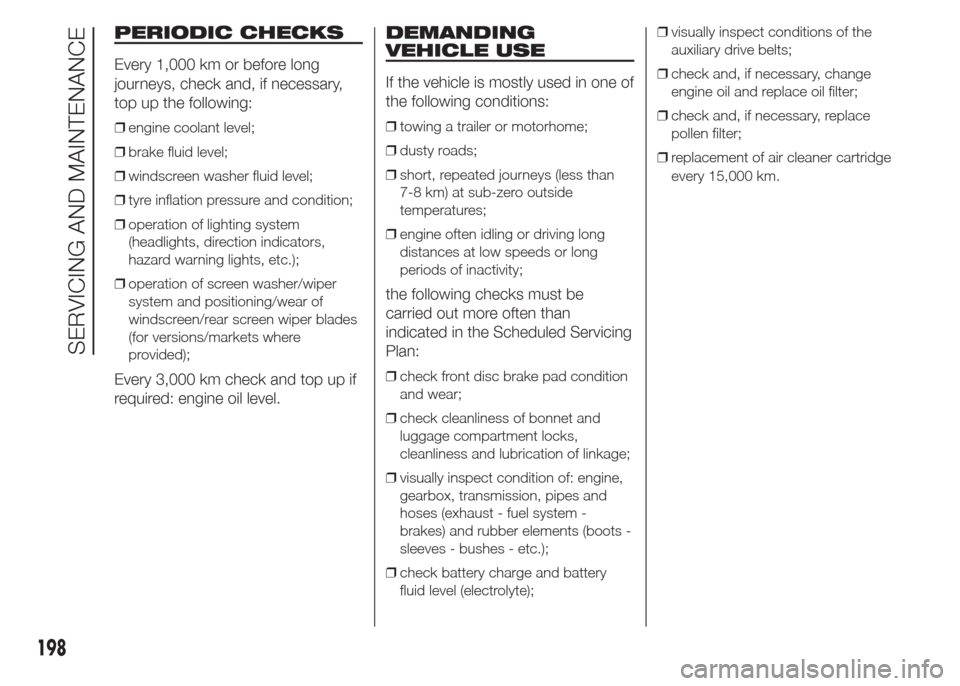
PERIODIC CHECKS
Every 1,000 km or before long
journeys, check and, if necessary,
top up the following:
âť’engine coolant level;
âť’brake fluid level;
âť’windscreen washer fluid level;
âť’tyre inflation pressure and condition;
âť’operation of lighting system
(headlights, direction indicators,
hazard warning lights, etc.);
âť’operation of screen washer/wiper
system and positioning/wear of
windscreen/rear screen wiper blades
(for versions/markets where
provided);
Every 3,000 km check and top up if
required: engine oil level.
DEMANDING
VEHICLE USE
If the vehicle is mostly used in one of
the following conditions:
âť’towing a trailer or motorhome;
âť’dusty roads;
âť’short, repeated journeys (less than
7-8 km) at sub-zero outside
temperatures;
âť’engine often idling or driving long
distances at low speeds or long
periods of inactivity;
the following checks must be
carried out more often than
indicated in the Scheduled Servicing
Plan:
âť’check front disc brake pad condition
and wear;
âť’check cleanliness of bonnet and
luggage compartment locks,
cleanliness and lubrication of linkage;
âť’visually inspect condition of: engine,
gearbox, transmission, pipes and
hoses (exhaust - fuel system -
brakes) and rubber elements (boots -
sleeves - bushes - etc.);
âť’check battery charge and battery
fluid level (electrolyte);âť’visually inspect conditions of the
auxiliary drive belts;
âť’check and, if necessary, change
engine oil and replace oil filter;
âť’check and, if necessary, replace
pollen filter;
âť’replacement of air cleaner cartridge
every 15,000 km.
198
SERVICING AND MAINTENANCE
Page 203 of 323
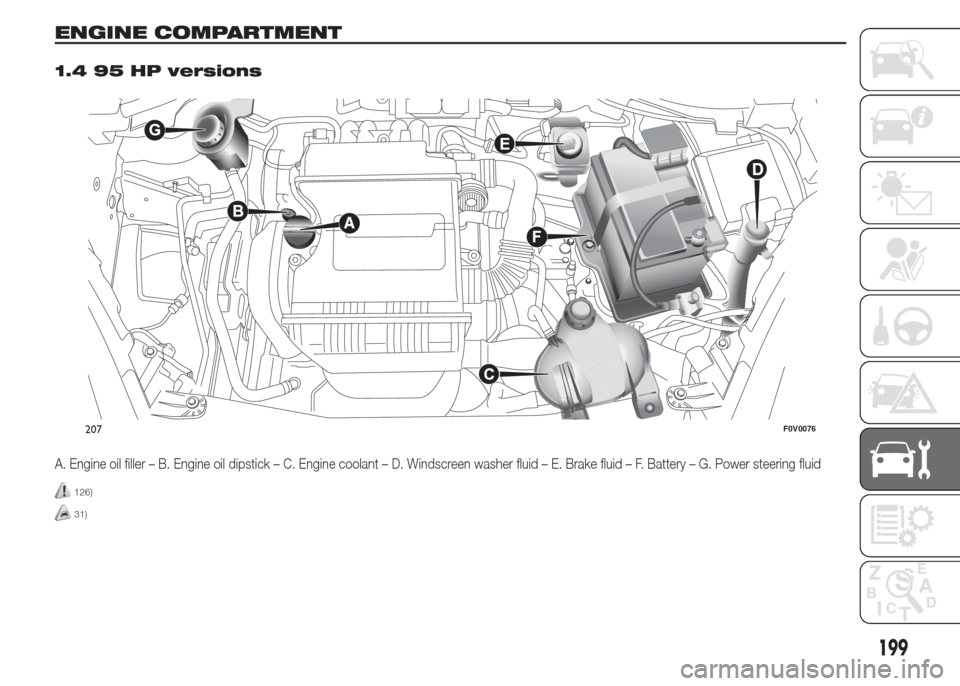
ENGINE COMPARTMENT.
1.4 95 HP versions
A. Engine oil filler – B. Engine oil dipstick – C. Engine coolant – D. Windscreen washer fluid – E. Brake fluid – F. Battery – G. Power steering fluid
126)
31)
207F0V0076
199
Page 204 of 323
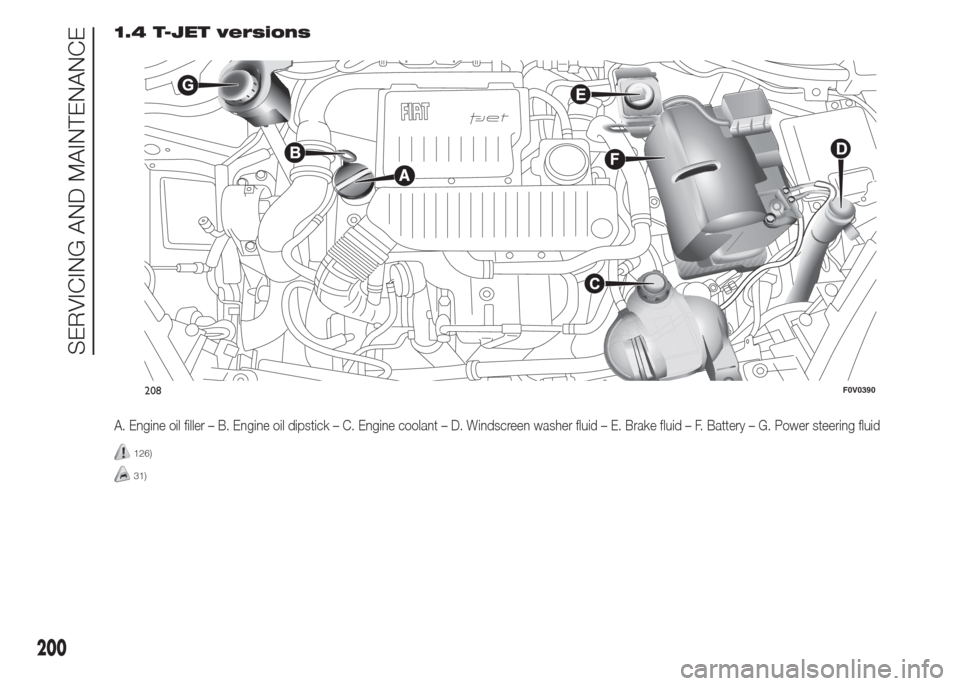
1.4 T-JET versions
A. Engine oil filler – B. Engine oil dipstick – C. Engine coolant – D. Windscreen washer fluid – E. Brake fluid – F. Battery – G. Power steering fluid
126)
31)
208F0V0390
200
SERVICING AND MAINTENANCE
Page 205 of 323
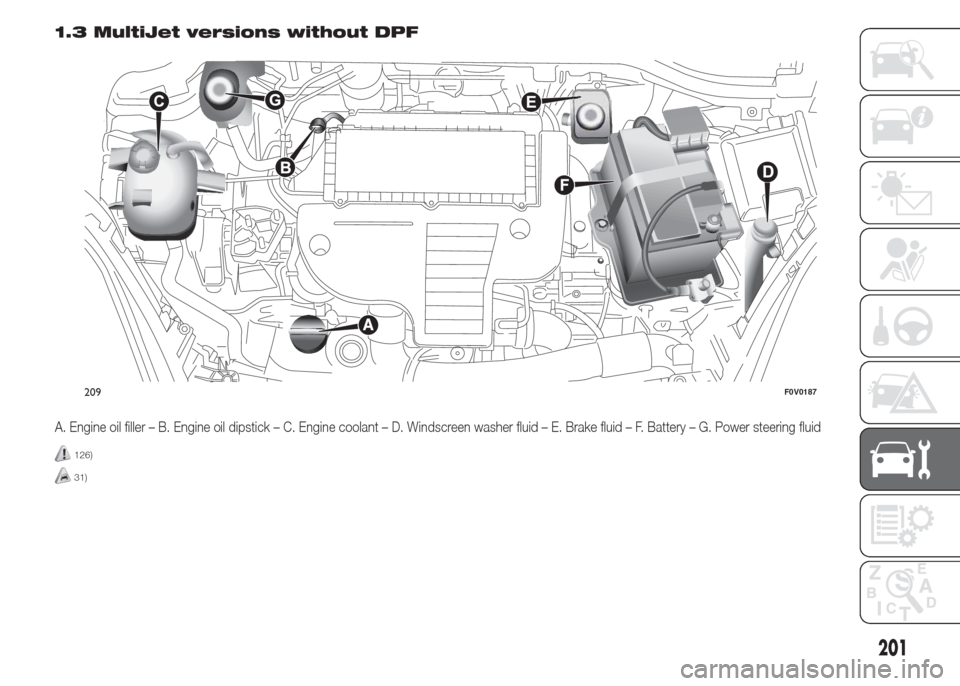
1.3 MultiJet versions without DPF
A. Engine oil filler – B. Engine oil dipstick – C. Engine coolant – D. Windscreen washer fluid – E. Brake fluid – F. Battery – G. Power steering fluid
126)
31)
209F0V0187
201
Page 206 of 323
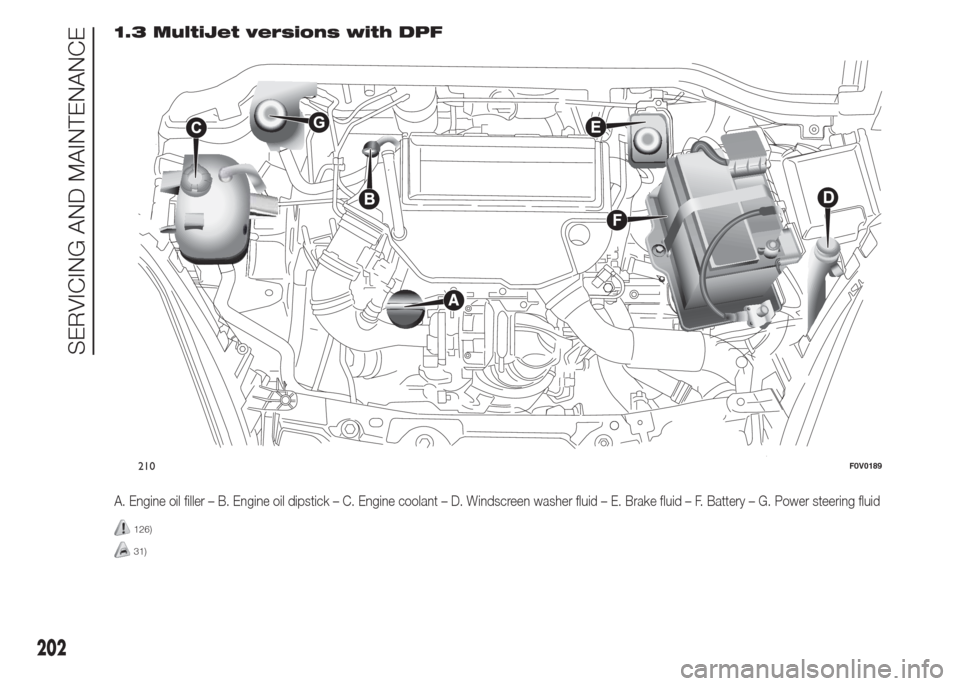
1.3 MultiJet versions with DPF
A. Engine oil filler – B. Engine oil dipstick – C. Engine coolant – D. Windscreen washer fluid – E. Brake fluid – F. Battery – G. Power steering fluid
126)
31)
210F0V0189
202
SERVICING AND MAINTENANCE
Page 207 of 323
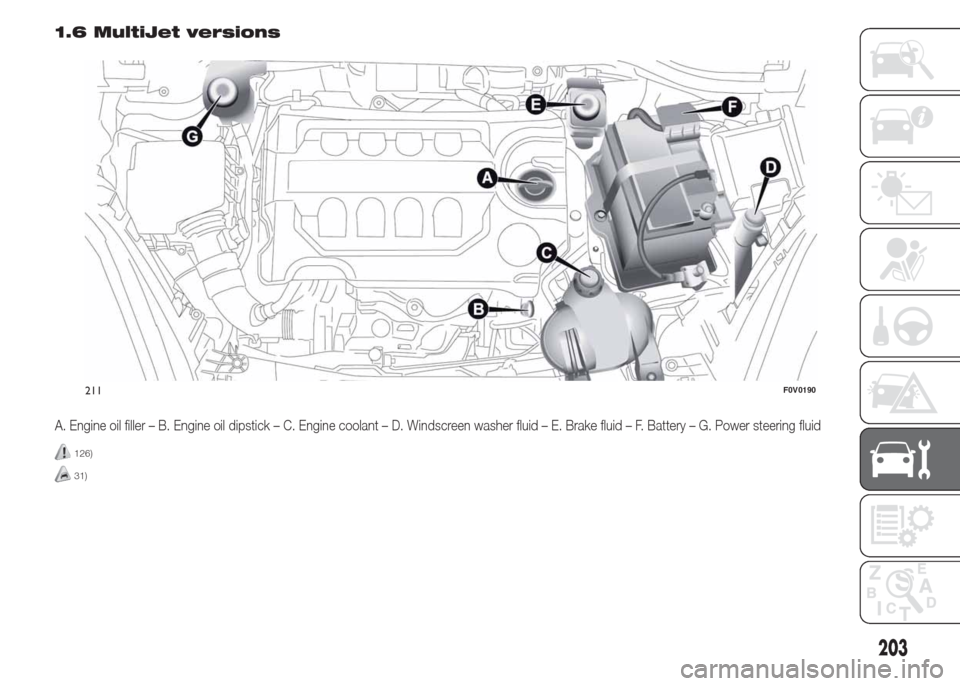
1.6 MultiJet versions
A. Engine oil filler – B. Engine oil dipstick – C. Engine coolant – D. Windscreen washer fluid – E. Brake fluid – F. Battery – G. Power steering fluid
126)
31)
211F0V0190
203
Page 208 of 323
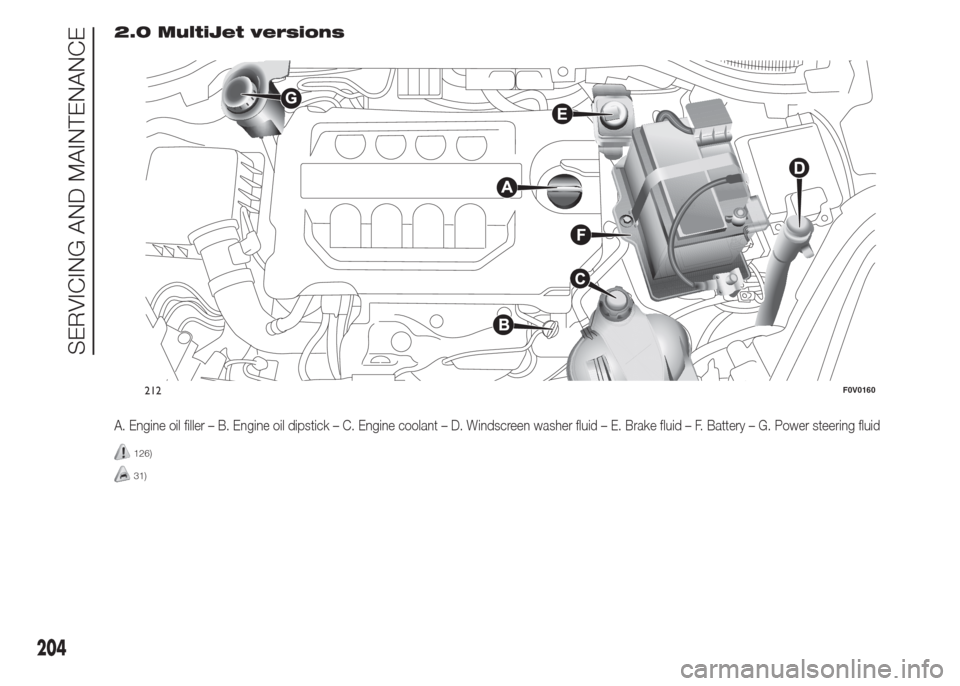
2.0 MultiJet versions
A. Engine oil filler – B. Engine oil dipstick – C. Engine coolant – D. Windscreen washer fluid – E. Brake fluid – F. Battery – G. Power steering fluid
126)
31)
212F0V0160
204
SERVICING AND MAINTENANCE
Page 209 of 323
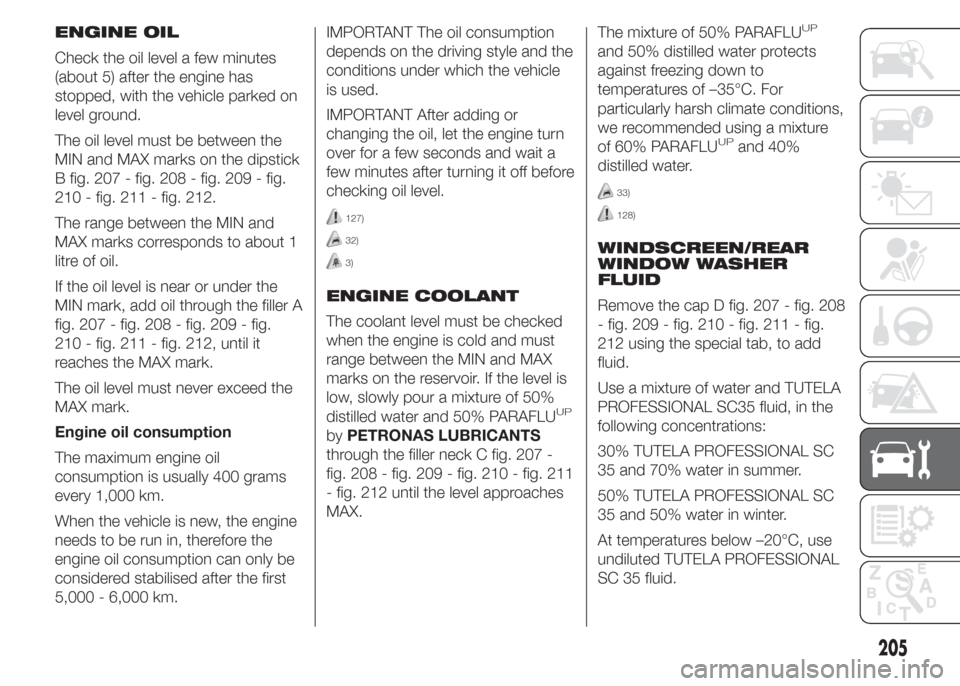
ENGINE OIL
Check the oil level a few minutes
(about 5) after the engine has
stopped, with the vehicle parked on
level ground.
The oil level must be between the
MIN and MAX marks on the dipstick
B fig. 207 - fig. 208 - fig. 209 - fig.
210 - fig. 211 - fig. 212.
The range between the MIN and
MAX marks corresponds to about 1
litre of oil.
If the oil level is near or under the
MIN mark, add oil through the filler A
fig. 207 - fig. 208 - fig. 209 - fig.
210 - fig. 211 - fig. 212, until it
reaches the MAX mark.
The oil level must never exceed the
MAX mark.
Engine oil consumption
The maximum engine oil
consumption is usually 400 grams
every 1,000 km.
When the vehicle is new, the engine
needs to be run in, therefore the
engine oil consumption can only be
considered stabilised after the first
5,000 - 6,000 km.IMPORTANT The oil consumption
depends on the driving style and the
conditions under which the vehicle
is used.
IMPORTANT After adding or
changing the oil, let the engine turn
over for a few seconds and wait a
few minutes after turning it off before
checking oil level.
127)
32)
3)
ENGINE COOLANT
The coolant level must be checked
when the engine is cold and must
range between the MIN and MAX
marks on the reservoir. If the level is
low, slowly pour a mixture of 50%
distilled water and 50% PARAFLU
UP
byPETRONAS LUBRICANTS
through the filler neck C fig. 207 -
fig. 208 - fig. 209 - fig. 210 - fig. 211
- fig. 212 until the level approaches
MAX.The mixture of 50% PARAFLU
UP
and 50% distilled water protects
against freezing down to
temperatures of –35°C. For
particularly harsh climate conditions,
we recommended using a mixture
of 60% PARAFLU
UPand 40%
distilled water.
33)
128)
WINDSCREEN/REAR
WINDOW WASHER
FLUID
Remove the cap D fig. 207 - fig. 208
- fig. 209 - fig. 210 - fig. 211 - fig.
212 using the special tab, to add
fluid.
Use a mixture of water and TUTELA
PROFESSIONAL SC35 fluid, in the
following concentrations:
30% TUTELA PROFESSIONAL SC
35 and 70% water in summer.
50% TUTELA PROFESSIONAL SC
35 and 50% water in winter.
At temperatures below –20°C, use
undiluted TUTELA PROFESSIONAL
SC 35 fluid.
205
Page 210 of 323
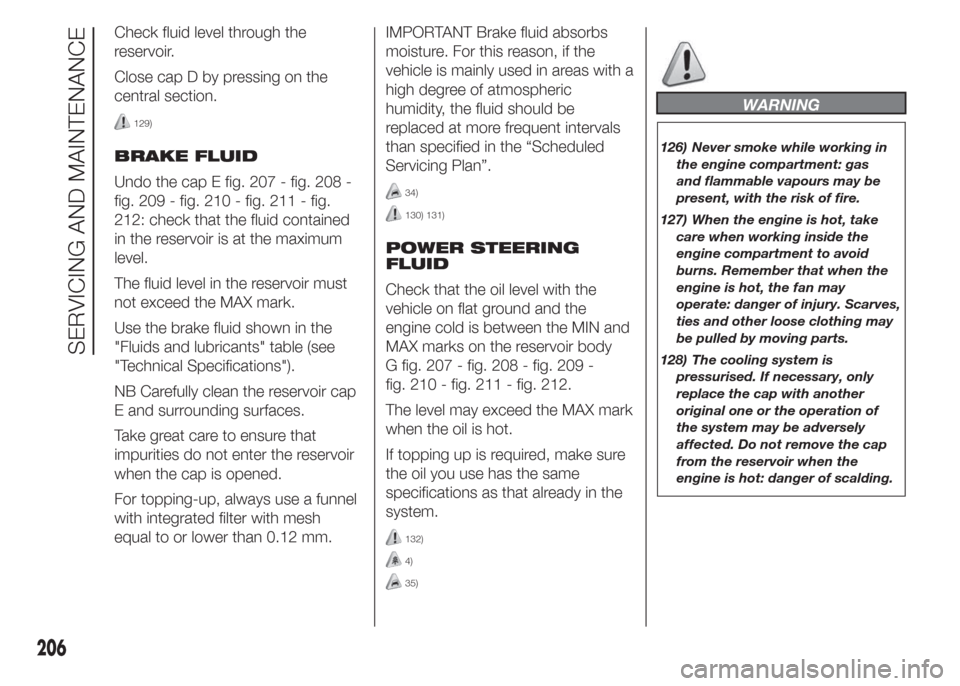
Check fluid level through the
reservoir.
Close cap D by pressing on the
central section.
129)
BRAKE FLUID
Undo the cap E fig. 207 - fig. 208 -
fig. 209 - fig. 210 - fig. 211 - fig.
212: check that the fluid contained
in the reservoir is at the maximum
level.
The fluid level in the reservoir must
not exceed the MAX mark.
Use the brake fluid shown in the
"Fluids and lubricants" table (see
"Technical Specifications").
NB Carefully clean the reservoir cap
E and surrounding surfaces.
Take great care to ensure that
impurities do not enter the reservoir
when the cap is opened.
For topping-up, always use a funnel
with integrated filter with mesh
equal to or lower than 0.12 mm.IMPORTANT Brake fluid absorbs
moisture. For this reason, if the
vehicle is mainly used in areas with a
high degree of atmospheric
humidity, the fluid should be
replaced at more frequent intervals
than specified in the “Scheduled
Servicing Plan”.
34)
130) 131)
POWER STEERING
FLUID
Check that the oil level with the
vehicle on flat ground and the
engine cold is between the MIN and
MAX marks on the reservoir body
G fig. 207 - fig. 208 - fig. 209 -
fig. 210 - fig. 211 - fig. 212.
The level may exceed the MAX mark
when the oil is hot.
If topping up is required, make sure
the oil you use has the same
specifications as that already in the
system.
132)
4)
35)
WARNING
126) Never smoke while working in
the engine compartment: gas
and flammable vapours may be
present, with the risk of fire.
127) When the engine is hot, take
care when working inside the
engine compartment to avoid
burns. Remember that when the
engine is hot, the fan may
operate: danger of injury. Scarves,
ties and other loose clothing may
be pulled by moving parts.
128) The cooling system is
pressurised. If necessary, only
replace the cap with another
original one or the operation of
the system may be adversely
affected. Do not remove the cap
from the reservoir when the
engine is hot: danger of scalding.
206
SERVICING AND MAINTENANCE